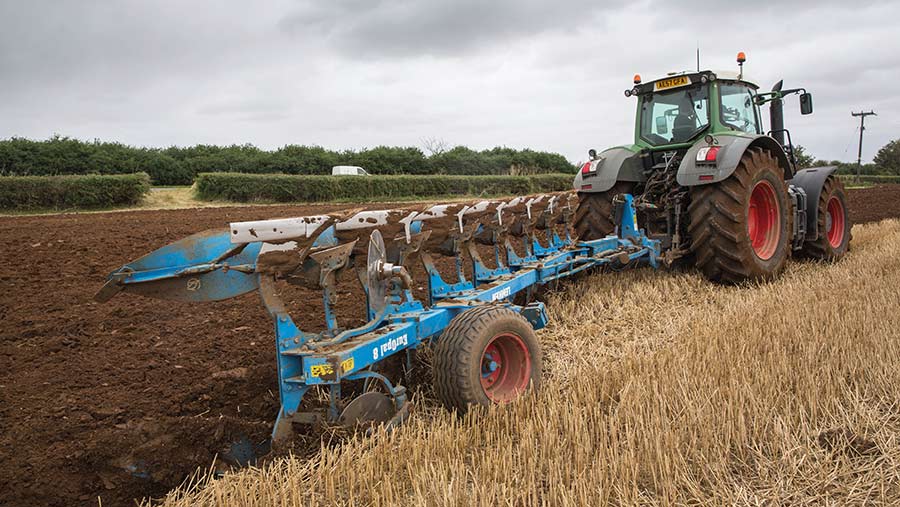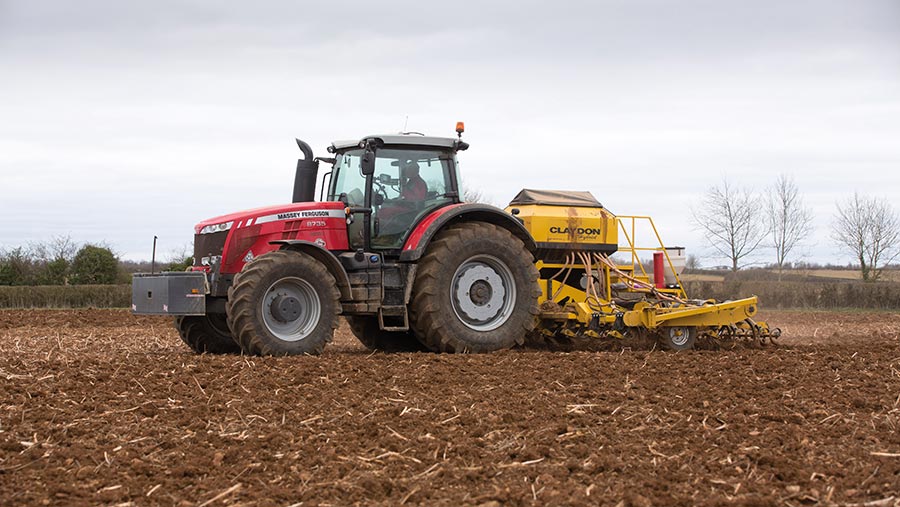5 cultivation and establishment methods compared
 © Tim Scrivener
© Tim Scrivener Establishment systems cover varying degrees of soil movement, from relatively little disturbance associated with direct-drilling and min-till through to deep cultivations and complete inversion with the likes of ploughing.
Each approach has its pros and cons, and no single approach will suit all situations, which often makes it challenging to assess which system will suit a farm’s cropping system the best.
Soil type, rainfall, weed pressure and drainage are just a few of the many factors that influence farmers’ cultivation choice.
We compare a range of cultivation practices to help farmers identify which establishment method may suit them this autumn.
See also: How one farmer tackled invasive grassweed rat’s tail fescue
1. Ploughing
Viewed as a “conventional” cultivation, ploughing is the deep inversion and burial of surface residues, working the soil at typical depths of 20-40 cm.
Timely ploughing reduces compaction, capping and slumping risks on silty and sandy soils.
Although ploughing often produces good soil physical conditions, it can degrade soils over time, which is why ensuring plough conditions, setting and timing are appropriate.
“A poorly planned ploughing operation wastes time and energy,” explains Harry Henderson, AHDB knowledge exchange manager.
He, therefore, advises growers when ploughing to consider:
- Setting skimmers to effectively bury trash
- Controlling speed to produce the best finish
- Choosing a plough depth to suit the soil type, not tractor capacity
- The share width is less than the furrow width
- If and when to press
- Subsoiling where deeper loosening is needed and deciding whether to subsoil then plough, or plough then subsoil.
- Using loosening units on plough bodies where soil depth and stone content are not limiting. Avoid plough body looseners where soil moisture levels at and beneath plough depth are plastic
Pros
- Gives a residue-free surface and a “clean start”
- Buries weed seeds below emergence depth
- Enhances biological breakdown of residual herbicides
- Loosens compaction down to plough depth
- Mineralises nutrients for availability in the following crop
- Option of pressing (flexibility to suit conditions)
- Capable of operation in wetter conditions than other systems
Cons
- The residue-free surface can be prone to slumping
- Can bring up buried weed seeds, if ploughing is frequent
- Oxidises organic matter, which reduces soil resilience
- High soil disturbance destroys natural supportive structure
- Risk of mineralised nutrients being lost to the atmosphere
- Pressed soil can slump and loose soil can lose moisture
- High cost, low output (relative to some other options)
2. Deep non-inversion
This technique is a lower-cost alternative to ploughing, working the soil to 20-35 cm. Crop residues are mixed into the top soil, while any potential subsurface compaction can be restructured.
“Perhaps this technique is now coming out of fashion slightly, but it is certainly worth mentioning.
“Growers should know the depth of compaction they want to mechanically restructure and set the machine to just below this depth,” says Mr Henderson.
Pros
- Retains the natural soil profile
- Removes subsurface compaction
- Enhances biological breakdown of residual herbicides
- Mineralises nutrients for availability in the following crop
- Pressing as part of the operation gives a weatherproof finish
- Often lower cost than ploughing
- Combined deep and shallow operations in one pass
Cons
- Relatively high soil movement can compromise structure resilience
- Mixes weed seeds through the profile (uncontrolled emergence can result)
- Some risk of mineralised nutrients being lost to the atmosphere
- Can leave a firm surface prone to slumping
- High cost compared to less intrusive systems
- Less flexibility, if deep tillage is not required on some areas
- Usually reliant on rotations and/or chemicals for weed control
3. Shallow non-inversion
Most often used where cereals, pulses and oilseeds are grown in the rotation, this technique involves shallow surface movement at 5-10cm using discs or tines.
Suited to self-structuring soil types, it also helps alleviate slug pressure via its shallow tillage and consolidation.
The method requires controlled traffic farming and/or low ground pressure technologies to avoid deeper soil damage. Most crop residues remain on the soil surface and it can be combined with low surface disturbance loosening as a separate operation.
Pros
- Retains the natural soil profile (surface tilth and subsurface structure)
- Leaves residues on or near the surface shallow mixed (stale seed-bed)
- Ability to control slug numbers
- Pressing as part of the operation gives a weatherproof finish
- Low cost, high output
- Removes compaction, if combined with low-disturbance loosening
Cons
- Needs a well-structured subsurface to prevent barriers
- Tine-based can block easily in residues
- Disc-based can smear in damp soils
- Requires a drill capable of operating in high residues
- If combined with loosening, more passes are required
- Often reliant on rotations and/or chemicals for weed control
4. Strip tillage
Rather than cultivating an entire field, this technique cultivates the strip in which crops grow, working at a depth of 5-10cm.
Again, most crop residues remain on the soil surface and in some situations this method can be considered a form of direct-drilling.
Pros
- Combines the soil-drying and warming benefits of conventional cultivations with the soil-protecting advantages of no-till
- Works on a proportion of the field so reduces overall soil movement
- Retains undisturbed soil columns to support traffic and drainage
- Can be split into cultivation and drilling, for flexibility
- Option to place fertiliser in drilling zone can save input costs
- Can provide a stepping stone to no-till or direct-drilling
- Potential for companion cropping between strips
Cons
- Different surface conditions/residue levels can increase threats of slugs and carry-over of certain diseases
- Gives different surface conditions for weed and pest control measures
- Higher draft than shallow tillage (although less than full-width tillage)
- Care required to avoid throwing disturbed soil on uncultivated strips
- Can be limited for deeper operation (for example, in high moisture situations)
- Higher levels of residues imply zone placement of fertiliser is needed
- Residue manager options can be required to give clear drilling zones
- Often reliant on rotations and/or chemicals for weed control
5. Direct-drilling
Direct-drilling is a one-pass establishment system without a prior cultivation pass.
Two types of drill can be used, these being a cultivator-type, tine-based drill, which involves some soil movement and a no-till disc drill, which moves as little soil as possible.

© Tim Scrivener
Sometimes, the technique can use a form of cultivation to loosen topsoil before seed placement, but where no soil movement occurs, this is known as “no-till” or “zero-till”.
“No-till is a specialist operation that takes quite a sizable change in a farming system to make it work well,” says Mr Henderson.
However, when used appropriately it can benefit soil biology and fertility to make soils more resilient.
Pros
- A single-pass system with flexibility for some cultivation
- Allows appropriate mix of tillage and drilling on soils needing both
- Low cost of operation (other than capital investment)
- Reasonable/high output
- Low disturbance for weed management and, as needed, some structuring
- Improvement of soil structure and biological activity over time
Cons
- Effective residue management, good soil structure and ideally a tilth needs to be present
- Requires specialist kit, although the system can be based around a cultivator drill
- Residue manager (row sweep) options can be required to give clear drilling zones
- Higher levels of residues combined with minimal soil disturbance imply zone placement of fertiliser can be required
- Soils sometimes need restructuring as a separate pass
- Generally reliant on rotations and/or chemicals for weed control
Harry Henderson, AHDB knowledge exchange manager, was talking at an AHDB webinar discussing autumn cultivations and winter crop establishment.
